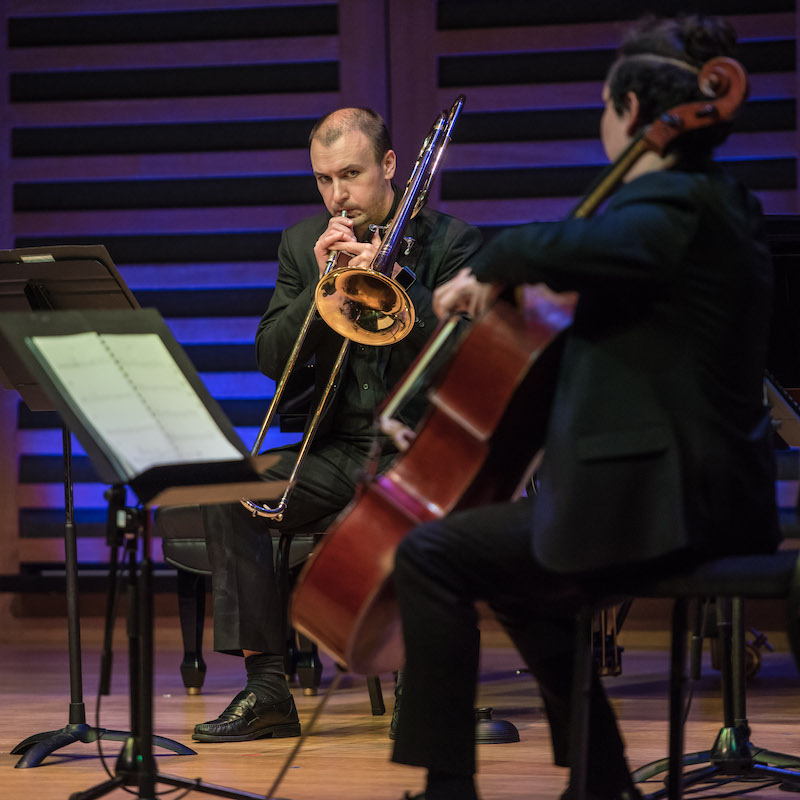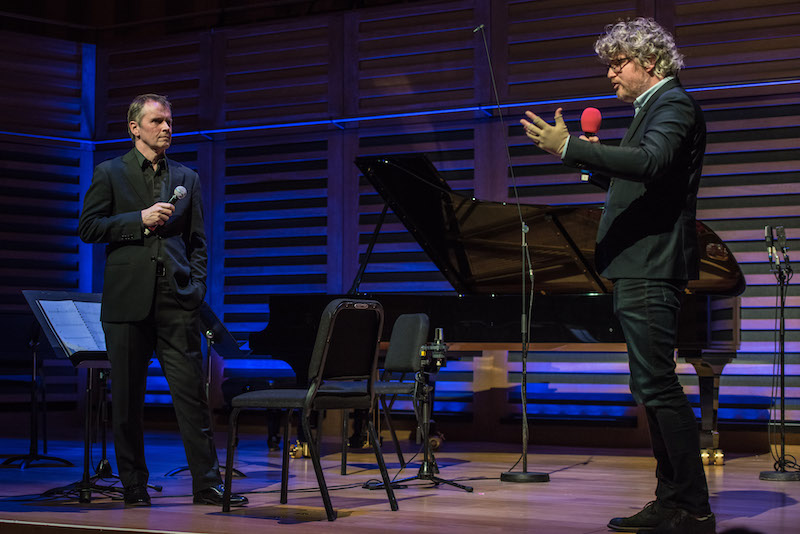Osborne, Aurora Orchestra, Kings Place review – live music that lives and breathes | reviews, news & interviews
Osborne, Aurora Orchestra, Kings Place review – live music that lives and breathes
Osborne, Aurora Orchestra, Kings Place review – live music that lives and breathes
Good-natured Mozart and stern Shostakovich make a successful partnership

Like a hokey-cokey, we’re back to live music in London – but for how long? I overheard another audience member explaining it was her third time at Kings Place this week, as people cram in as many concerts as possible before a feared return to cultural lockdown.
The format was the same as the Imogen Cooper concert I reviewed in October: starry soloist, Mozart concerto in chamber arrangement, new commission from a young composer and a warhorse from the chamber repertoire, in this case Shostakovich’s Piano Quintet. And it was very enjoyable, if perhaps without quite the same level of sparkle and joy that Cooper prompted.
Mozart’s Piano Concerto No. 23 is genial and conversational, with a haunting slow movement and a rollicking finale. The chamber arrangement by Ignaz Lachner dates from the 19th century and keeps the piano part unchanged while reducing the orchestra to a string quartet plus double bass. It works very well, in particular freeing up the cello from its role in the original simply doubling the bass to a wider brief, playing a variety of inner lines in the texture, cellist Sébastien van Kuijk revelling in each identity. Steven Osborne’s playing was intimate and warm, especially in the hymn-like first movement second subject. The tender opening of the second movement – so, so hard to capture – was delicious, as was the bleak ending. In the finale his scales flowed like water and the ensemble was rock solid as the cello and bass scurried and danced. The minutes flew by.
Steven Osborne’s playing was intimate and warm, especially in the hymn-like first movement second subject. The tender opening of the second movement – so, so hard to capture – was delicious, as was the bleak ending. In the finale his scales flowed like water and the ensemble was rock solid as the cello and bass scurried and danced. The minutes flew by.
Sylvia Lim’s Points of Intersection, premiered here, is scored for the unusual (unique?) combination of trombone and string quartet. She explained the piece is “about lines that move and shift and sometimes overlap” and that she wanted the trombone to integrate into the ensemble rather than be a soloist. Of course, a trombone does not naturally integrate into a string quartet (or else there might be more pieces for this combination), especially when the strings are playing quietly throughout. The trombonist (a committed Matthew Gee, pictured above) instead blew air through the instrument, found a kind of mezzo-voce sound and at one stage produced a slightly undignified kind of muffled fart.
The parts given to the strings were much more convincing, exploring microtones, a variety of misty sounds where the bow pressure on the string was varied, conjuring a vaguely throbbing, sliding timbre that was elusive but attractive. But for all these intriguing sounds the composer’s self-denial of so many basic musical elements – melody, rhythm, harmony – gave the piece something of a hair-shirt aspect.
 The concert was hosted by Radio 3’s Tom Service (pictured above), including interviews with Sylvia Lim and Steven Osborne. He is a very fluent speaker and maintains an indefatigably Tiggerish enthusiasm for the music, but there was slightly too high a chat-to-music ratio for my liking, and the constant exhortions to supply yet another round of applause became a bit wearying.
The concert was hosted by Radio 3’s Tom Service (pictured above), including interviews with Sylvia Lim and Steven Osborne. He is a very fluent speaker and maintains an indefatigably Tiggerish enthusiasm for the music, but there was slightly too high a chat-to-music ratio for my liking, and the constant exhortions to supply yet another round of applause became a bit wearying.
The Shostakovich piano quintet provided fare that was sterner than the Mozart, weightier than the Lim and more concise than Tom Service. Here, Osborne’s previous restraint was cast aside as he threw himself into the declaratory opening solo. The tumultuous first movement gave way to a fragile fugue, led off by first violin Alexandra Wood, playing with the minimum of vibrato, which built to a passionate climax with affecting solos by cello and viola (Ruth Gibson).
The motoric scherzo showed Shostakovich’s command of pacing within the piece, the ensemble driving to the ending with complete conviction. The finale offers glimpses of the good-humoured Shostakovich of his sixth quartet, interspersed with fiery interludes, Osborne alternating between discursive melodies and pounding rhythms. Then the most extraordinary final few bars, suddenly like salon music, delivered here with exquisite élan, presenting a new idea right at the end which is, like Keyser Söze, gone before you know it.
rating
Explore topics
Share this article
The future of Arts Journalism
You can stop theartsdesk.com closing!
We urgently need financing to survive. Our fundraising drive has thus far raised £49,000 but we need to reach £100,000 or we will be forced to close. Please contribute here: https://gofund.me/c3f6033d
And if you can forward this information to anyone who might assist, we’d be grateful.

Subscribe to theartsdesk.com
Thank you for continuing to read our work on theartsdesk.com. For unlimited access to every article in its entirety, including our archive of more than 15,000 pieces, we're asking for £5 per month or £40 per year. We feel it's a very good deal, and hope you do too.
To take a subscription now simply click here.
And if you're looking for that extra gift for a friend or family member, why not treat them to a theartsdesk.com gift subscription?
more Classical music
 Hallé John Adams festival, Bridgewater Hall / RNCM, Manchester review - standing ovations for today's music
From 1980 to 2025 with the West Coast’s pied piper and his eager following
Hallé John Adams festival, Bridgewater Hall / RNCM, Manchester review - standing ovations for today's music
From 1980 to 2025 with the West Coast’s pied piper and his eager following
 Kaploukhii, Greenwich Chamber Orchestra, Cutts, St James's Piccadilly review - promising young pianist
A robust and assertive Beethoven concerto suggests a player to follow
Kaploukhii, Greenwich Chamber Orchestra, Cutts, St James's Piccadilly review - promising young pianist
A robust and assertive Beethoven concerto suggests a player to follow
 Robin Holloway: Music's Odyssey review - lessons in composition
Broad and idiosyncratic survey of classical music is insightful but slightly indigestible
Robin Holloway: Music's Odyssey review - lessons in composition
Broad and idiosyncratic survey of classical music is insightful but slightly indigestible
 Classical CDs: Wolf-pelts, clowns and social realism
British ballet scores, 19th century cello works and contemporary piano etudes
Classical CDs: Wolf-pelts, clowns and social realism
British ballet scores, 19th century cello works and contemporary piano etudes
 Bizet in 150th anniversary year: rich and rare French offerings from Palazzetto Bru Zane
Specialists in French romantic music unveil a treasure trove both live and on disc
Bizet in 150th anniversary year: rich and rare French offerings from Palazzetto Bru Zane
Specialists in French romantic music unveil a treasure trove both live and on disc
 Scottish Chamber Orchestra, Ibragimova, Queen’s Hall, Edinburgh review - rarities, novelties and drumrolls
A pity the SCO didn't pick a better showcase for a shining guest artist
Scottish Chamber Orchestra, Ibragimova, Queen’s Hall, Edinburgh review - rarities, novelties and drumrolls
A pity the SCO didn't pick a better showcase for a shining guest artist
 Kilsby, Parkes, Sinfonia of London, Wilson, Barbican review - string things zing and sing in expert hands
British masterpieces for strings plus other-worldly tenor and horn - and a muscular rarity
Kilsby, Parkes, Sinfonia of London, Wilson, Barbican review - string things zing and sing in expert hands
British masterpieces for strings plus other-worldly tenor and horn - and a muscular rarity
 From Historical to Hip-Hop, Classically Black Music Festival, Kings Place review - a cluster of impressive stars for the future
From quasi-Mozartian elegance to the gritty humour of a kitchen inspection
From Historical to Hip-Hop, Classically Black Music Festival, Kings Place review - a cluster of impressive stars for the future
From quasi-Mozartian elegance to the gritty humour of a kitchen inspection
 Shibe, LSO, Adès, Barbican review - gaudy and glorious new music alongside serene Sibelius
Adès’s passion makes persuasive case for the music he loves, both new and old
Shibe, LSO, Adès, Barbican review - gaudy and glorious new music alongside serene Sibelius
Adès’s passion makes persuasive case for the music he loves, both new and old
 Anja Mittermüller, Richard Fu, Wigmore Hall review - a glorious hall debut
The Austrian mezzo shines - at the age of 22
Anja Mittermüller, Richard Fu, Wigmore Hall review - a glorious hall debut
The Austrian mezzo shines - at the age of 22
 First Person: clarinettist Oliver Pashley on the new horizons of The Hermes Experiment's latest album
Compositions by members of this unusual quartet feature for the first time
First Person: clarinettist Oliver Pashley on the new horizons of The Hermes Experiment's latest album
Compositions by members of this unusual quartet feature for the first time

Add comment